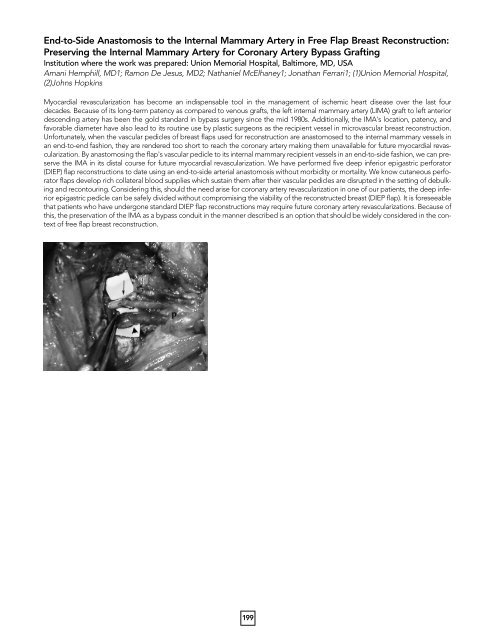Floor plan - 2013 Annual Meeting - American Association for Hand ...
Floor plan - 2013 Annual Meeting - American Association for Hand ...
Floor plan - 2013 Annual Meeting - American Association for Hand ...
You also want an ePaper? Increase the reach of your titles
YUMPU automatically turns print PDFs into web optimized ePapers that Google loves.
End-to-Side Anastomosis to the Internal Mammary Artery in Free Flap Breast Reconstruction:<br />
Preserving the Internal Mammary Artery <strong>for</strong> Coronary Artery Bypass Grafting<br />
Institution where the work was prepared: Union Memorial Hospital, Baltimore, MD, USA<br />
Amani Hemphill, MD1; Ramon De Jesus, MD2; Nathaniel McElhaney1; Jonathan Ferrari1; (1)Union Memorial Hospital,<br />
(2)Johns Hopkins<br />
Myocardial revascularization has become an indispensable tool in the management of ischemic heart disease over the last four<br />
decades. Because of its long-term patency as compared to venous grafts, the left internal mammary artery (LIMA) graft to left anterior<br />
descending artery has been the gold standard in bypass surgery since the mid 1980s. Additionally, the IMA's location, patency, and<br />
favorable diameter have also lead to its routine use by plastic surgeons as the recipient vessel in microvascular breast reconstruction.<br />
Un<strong>for</strong>tunately, when the vascular pedicles of breast flaps used <strong>for</strong> reconstruction are anastomosed to the internal mammary vessels in<br />
an end-to-end fashion, they are rendered too short to reach the coronary artery making them unavailable <strong>for</strong> future myocardial revascularization.<br />
By anastomosing the flap's vascular pedicle to its internal mammary recipient vessels in an end-to-side fashion, we can preserve<br />
the IMA in its distal course <strong>for</strong> future myocardial revascularization. We have per<strong>for</strong>med five deep inferior epigastric per<strong>for</strong>ator<br />
(DIEP) flap reconstructions to date using an end-to-side arterial anastomosis without morbidity or mortality. We know cutaneous per<strong>for</strong>ator<br />
flaps develop rich collateral blood supplies which sustain them after their vascular pedicles are disrupted in the setting of debulking<br />
and recontouring. Considering this, should the need arise <strong>for</strong> coronary artery revascularization in one of our patients, the deep inferior<br />
epigastric pedicle can be safely divided without compromising the viability of the reconstructed breast (DIEP flap). It is <strong>for</strong>eseeable<br />
that patients who have undergone standard DIEP flap reconstructions may require future coronary artery revascularizations. Because of<br />
this, the preservation of the IMA as a bypass conduit in the manner described is an option that should be widely considered in the context<br />
of free flap breast reconstruction.<br />
199



